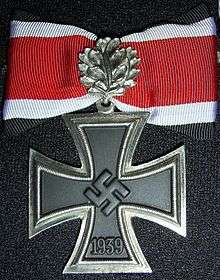Wilhelm Schöning
| Wilhelm Schöning | |
|---|---|
| Born |
8 June 1908 Gumbinnen, Germany |
| Died |
2 November 1987 (aged 79) Bochum, Germany |
| Allegiance |
|
| Years of service | ?–1945 |
| Rank | Oberstleutnant of the Reserves |
| Commands held | Panzergrenadier-Regiment 66 |
| Battles/wars | World War II |
| Awards |
Order of Michael the Brave Knight's Cross of the Iron Cross with Oak Leaves |
Georg Wilhelm Schöning (8 June 1908 – 2 November 1987) served as commander of the 66th Panzergrenadier Regiment of the 13th Panzer Division during the Siege of Budapest.
Siege
Most of the division was encircled and destroyed in Budapest between December and February 1944-45. The remnants which escaped, consisting of 200-300 men, were reformed under Schöning. Wounded during the battle by a hand grenade, Schöning managed to break through Soviet lines and reached the German 3rd Cavalry Brigade on the Buda side. Schöning remembered it thus:
Suddenly I had the feeling that my leg was being torn off. Division doctor Major Seeger, who was lying near me, wanted to help me. He bent over me and in so doing was himself wounded. Right at the start of the breakout he was shot in the leg which exposed his Achilles tendon and was then hit by another bullet which tore away his backside. As my pistol was empty I ordered my lieutenant to finish me off because I didn't want to be taken prisoner. He was himself wounded in the arm. He then called to me: “Only another 2,000 metres, Lieutenant Colonel. We have to make it!'” I crept through the snow up a hill with the major...Two wounded grenadiers from our battle group picked us up under the arms under the heaviest fire and stood us upright and I dragged myself with several wounds to the feet the two kilometres to the German position.[1]
Dates of Rank
- Leutnant
- Oberleutnant
- Hauptmann - 194x
- Major - 21 Jan 1945
- Oberstleutnant - 1945
Awards and decorations
- Iron Cross (1939)
- Infantry Assault Badge
- Wound Badge
- in Black or Silver
- Close Combat Clasp
- in Bronze
- Eastern Front Medal
- Honour Roll Clasp of the Army
- Order of Michael the Brave
- German Cross in Gold on 14 February 1942 as Oberleutnant in the 10./Infanterie-Regiment 120 (mototized)[3]
- Knight's Cross of the Iron Cross with Oak Leaves
References
Citations
- ↑ "The Battle for Hungary" Krisztián Ungváry, Budapest Times, 10 December 2007
- 1 2 Thomas 1998, p. 279.
- ↑ Patzwall & Scherzer 2001, p. 422.
Bibliography
- Fellgiebel, Walther-Peer (2000) [1986]. Die Träger des Ritterkreuzes des Eisernen Kreuzes 1939–1945 — Die Inhaber der höchsten Auszeichnung des Zweiten Weltkrieges aller Wehrmachtteile [The Bearers of the Knight's Cross of the Iron Cross 1939–1945 — The Owners of the Highest Award of the Second World War of all Wehrmacht Branches] (in German). Friedberg, Germany: Podzun-Pallas. ISBN 978-3-7909-0284-6.
- Patzwall, Klaus D.; Scherzer, Veit (2001). Das Deutsche Kreuz 1941 – 1945 Geschichte und Inhaber Band II [The German Cross 1941 – 1945 History and Recipients Volume 2] (in German). Norderstedt, Germany: Verlag Klaus D. Patzwall. ISBN 978-3-931533-45-8.
- Scherzer, Veit (2007). Die Ritterkreuzträger 1939–1945 Die Inhaber des Ritterkreuzes des Eisernen Kreuzes 1939 von Heer, Luftwaffe, Kriegsmarine, Waffen-SS, Volkssturm sowie mit Deutschland verbündeter Streitkräfte nach den Unterlagen des Bundesarchives [The Knight's Cross Bearers 1939–1945 The Holders of the Knight's Cross of the Iron Cross 1939 by Army, Air Force, Navy, Waffen-SS, Volkssturm and Allied Forces with Germany According to the Documents of the Federal Archives] (in German). Jena, Germany: Scherzers Miltaer-Verlag. ISBN 978-3-938845-17-2.
- Thomas, Franz (1998). Die Eichenlaubträger 1939–1945 Band 2: L–Z [The Oak Leaves Bearers 1939–1945 Volume 2: L–Z] (in German). Osnabrück, Germany: Biblio-Verlag. ISBN 978-3-7648-2300-9.
This article is issued from Wikipedia - version of the 12/2/2016. The text is available under the Creative Commons Attribution/Share Alike but additional terms may apply for the media files.
